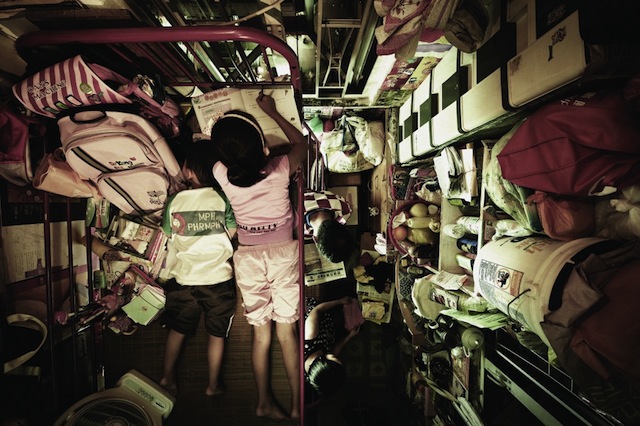Hong Kong's cramped housing ignites photographers' muse


HONG KONG -- The thought of Hong Kong often conjures images of shiny skyscrapers and glamorous living, and that would not be inaccurate portrayal.
But photos of people living in subdivided homes show a reality borne by thousands of the city's residents. Subdivided apartments, which are sections of flats separated by additional walls, are just slightly wider than the average arm span. They are also illegal. But entire families dwell in the apartments because it is what they can afford in a city that has seen skyrocketing rents.
As local photographers have been able to demonstrate, these living conditions can also make for the subject of dramatic and captivating photographs.
“Generally it would be hard to get ordinary members of public engaged enough to come to a dry seminar on poverty. However, it is far easier to engage them through photography,” said Belinda Winterbourne, the chief executive of WYNG Foundation, an awareness group that held a photo competition and exhibition earlier this year with poverty as its theme.
Finalists of the competition, called the WYNG Masters Award, created a series of photos that captured poverty in varying ways, one photographing groceries to represent the amount of food the poor can buy, another producing black-and-white images of street sleepers.
The issue of poverty has gained public and government attention over recent years, with a poverty line expected to be established for the first time later this year. A widening wealth disparity in the financial center is the crux of the problem, according to concern groups. “All along our economy has been growing, but because there hasn’t been good distribution, low-income individuals’ income has not increased,” said Ho Hei-wah, the head of the Society of Community Organization.
Hong Kong has the largest number of billionaires in the world, on a per capita basis. Meanwhile, median personal income is only about US$1,500 per month. It also has the most expensive property market, and apartments are small even for the middle class: over 90% of families live in homes smaller than 700 square feet.
Perhaps the most extreme type of small home, which has come to uniquely symbolize Hong Kong’s housing problem, is the “cage” home phenomenon: for about US$150 a month, lessees live in a wire cage as a home, usually stacked in run-down residential buildings.
For those existing in the more desirable end of the rich-poor divide, the visualization of dire living conditions has largely come from poignant photographs that in the past few years have helped highlight Hong Kong’s lack of space and poverty.
“I work in wealth management, so it was a very different thing to see,” said Jonathan van Smit, a New Zealand native who has lived in Hong Kong for five years. He started doing community work for SOCO and was able to see firsthand the lives of those in extreme poverty. He made it a hobby of photographing the homeless and the poor whom he encountered.
In a series titled “Real Lives,” van Smit focused on cage homes. “For gweilos” -- or white foreigner -- “it’s challenging to access some of these places. They’re in housing blocks with security guards and so on. I find the people who live in them quite interesting as well.”
SOCO also regularly commissions photos and holds exhibitions. The group recently commissioned a series shot from above small homes, showing in some cases families and all their possessions crammed into a subdivided apartment.
“It is estimated that Hong Kong has 100,000 people living in subdivided apartments under poor conditions. Not only are these places infested with rodents but pose a constant fire hazard,” reads one of the photo captions on SOCO’s Facebook page.
Winterbourne points out poverty is more than a living condition but also a matter of dignity, and the visual representation provides information that many people would not normally seek out.
"A photo is worth a thousand words, and photographs offer concrete evidence of reality," she said.
This post was originally published on Smartplanet.com